Alkaline earth metal
The alkaline earth metals are six chemical elements in group 2 of the periodic table. They are beryllium (Be), magnesium (Mg), calcium (Ca), strontium (Sr), barium (Ba), and radium (Ra).[1] The elements have very similar properties: they are all shiny, silvery-white, somewhat reactive metals at standard temperature and pressure.[2]
| Alkaline earth metals | |||||||||||
|---|---|---|---|---|---|---|---|---|---|---|---|
| |||||||||||
| ↓ Period | |||||||||||
| 2 | 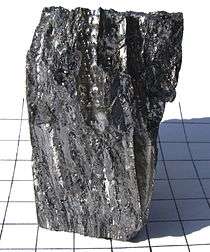 4 | ||||||||||
| 3 | 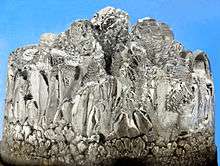 12 | ||||||||||
| 4 | 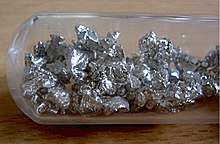 20 | ||||||||||
| 5 |  38 | ||||||||||
| 6 | 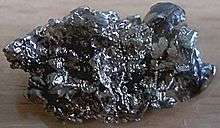 56 | ||||||||||
| 7 | 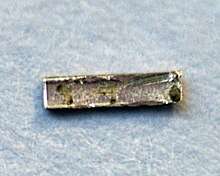 88 | ||||||||||
|
Legend
| |||||||||||
Structurally, they (together with helium) have in common an outer s-orbital which is full;[2][3][4] that is, this orbital contains its full complement of two electrons, which the alkaline earth metals readily lose to form cations with charge +2, and an oxidation state of +2.[5]
All the discovered alkaline earth metals occur in nature, although radium occurs only through the decay chain of uranium and thorium and not as a primordial element.[6] There have been experiments, all unsuccessful, to try to synthesize element 120, the next potential member of the group.
Characteristics
Chemical
As with other groups, the members of this family show patterns in their electronic configuration, especially the outermost shells, resulting in trends in chemical behavior:
| Z | Element | No. of electrons/shell | Electron configuration[n 1] |
|---|---|---|---|
| 4 | beryllium | 2, 2 | [He] 2s2 |
| 12 | magnesium | 2, 8, 2 | [Ne] 3s2 |
| 20 | calcium | 2, 8, 8, 2 | [Ar] 4s2 |
| 38 | strontium | 2, 8, 18, 8, 2 | [Kr] 5s2 |
| 56 | barium | 2, 8, 18, 18, 8, 2 | [Xe] 6s2 |
| 88 | radium | 2, 8, 18, 32, 18, 8, 2 | [Rn] 7s2 |
Most of the chemistry has been observed only for the first five members of the group. The chemistry of radium is not well-established due to its radioactivity;[2] thus, the presentation of its properties here is limited.
The alkaline earth metals are all silver-colored and soft, and have relatively low densities, melting points, and boiling points. In chemical terms, all of the alkaline earth metals react with the halogens to form the alkaline earth metal halides, all of which are ionic crystalline compounds (except for beryllium chloride, which is covalent). All the alkaline earth metals except beryllium also react with water to form strongly alkaline hydroxides and, thus, should be handled with great care. The heavier alkaline earth metals react more vigorously than the lighter ones.[2] The alkaline earth metals have the second-lowest first ionization energies in their respective periods of the periodic table[4] because of their somewhat low effective nuclear charges and the ability to attain a full outer shell configuration by losing just two electrons. The second ionization energy of all of the alkaline metals is also somewhat low.[2][4]
Beryllium is an exception: It does not react with water or steam, and its halides are covalent. If beryllium did form compounds with an ionization state of +2, it would polarize electron clouds that are near it very strongly and would cause extensive orbital overlap, since beryllium has a high charge density. All compounds that include beryllium have a covalent bond.[7] Even the compound beryllium fluoride, which is the most ionic beryllium compound, has a low melting point and a low electrical conductivity when melted.[8][9][10]
All the alkaline earth metals have two electrons in their valence shell, so the energetically preferred state of achieving a filled electron shell is to lose two electrons to form doubly charged positive ions.
Compounds and reactions
The alkaline earth metals all react with the halogens to form ionic halides, such as calcium chloride (CaCl
2), as well as reacting with oxygen to form oxides such as strontium oxide (SrO). Calcium, strontium, and barium react with water to produce hydrogen gas and their respective hydroxides, and also undergo transmetalation reactions to exchange ligands.
Alkaline earth metals fluorides solubility-related constants[n 2] Metal M2+
HE
[11]F−
HE
[12]"MF2"
unit
HEMF2
lattice
energies
[13]Solubility
[14]Be 2,455 458 3,371 3,526 soluble Mg 1,922 458 2,838 2,978 0.0012 Ca 1,577 458 2,493 2,651 0.0002 Sr 1,415 458 2,331 2,513 0.0008 Ba 1,361 458 2,277 2,373 0.006
Physical and atomic
The table below is a summary of the key physical and atomic properties of the alkaline earth metals.
| Alkaline earth metal | Standard atomic weight (u)[n 3][16][17] |
Melting point (K) |
Melting point (°C) |
Boiling point (K)[4] |
Boiling point (°C)[4] |
Density (g/cm3) |
Electronegativity (Pauling) |
First ionization energy (kJ·mol−1) | Covalent radius (pm)[18] |
Flame test color | |
|---|---|---|---|---|---|---|---|---|---|---|---|
| Beryllium | 9.012182(3) | 1560 | 1287 | 2742 | 2469 | 1.85 | 1.57 | 899.5 | 105 | White[19] | |
| Magnesium | 24.3050(6) | 923 | 650 | 1363 | 1090 | 1.738 | 1.31 | 737.7 | 150 | Brilliant-white[2] | |
| Calcium | 40.078(4) | 1115 | 842 | 1757 | 1484 | 1.54 | 1.00 | 589.8 | 180 | Brick-red[2] | |
| Strontium | 87.62(1) | 1050 | 777 | 1655 | 1382 | 2.64 | 0.95 | 549.5 | 200 | Crimson[2] | |
| Barium | 137.327(7) | 1000 | 727 | 2170 | 1897 | 3.594 | 0.89 | 502.9 | 215 | Apple-green[2] | |
| Radium | [226][n 4] | 973 | 700 | 2010 | 1737 | 5.5 | 0.9 | 509.3 | 221 | Crimson red[n 5] | |
Nuclear stability
Of the six alkaline earth metals, beryllium, calcium, barium, and radium have at least one naturally occurring radioisotope; magnesium and strontium do not. Beryllium-7, beryllium-10, and calcium-41 are trace radioisotopes; calcium-48 and barium-130 have very long half-lives and thus are primordial radionuclides; and all isotopes of radium are radioactive. Calcium-48 is the lightest nuclide to undergo double beta decay.[21] Calcium and barium are weakly radioactive: calcium contains about 0.1874% calcium-48,[22] and barium contains about 0.1062% barium-130.[23] The longest lived isotope of radium is radium-226 with a half-life of 1600 years; it and radium-223, -224, and -228 occur naturally in the decay chains of primordial thorium and uranium.
History
Etymology
The alkaline earth metals are named after their oxides, the alkaline earths, whose old-fashioned names were beryllia, magnesia, lime, strontia, and baryta. These oxides are basic (alkaline) when combined with water. "Earth" is an old term applied by early chemists to nonmetallic substances that are insoluble in water and resistant to heating—properties shared by these oxides. The realization that these earths were not elements but compounds is attributed to the chemist Antoine Lavoisier. In his Traité Élémentaire de Chimie (Elements of Chemistry) of 1789 he called them salt-forming earth elements. Later, he suggested that the alkaline earths might be metal oxides, but admitted that this was mere conjecture. In 1808, acting on Lavoisier's idea, Humphry Davy became the first to obtain samples of the metals by electrolysis of their molten earths,[24] thus supporting Lavoisier's hypothesis and causing the group to be named the alkaline earth metals.
Discovery
The calcium compounds calcite and lime have been known and used since prehistoric times.[25] The same is true for the beryllium compounds beryl and emerald.[26] The other compounds of the alkaline earth metals were discovered starting in the early 15th century. The magnesium compound magnesium sulfate was first discovered in 1618 by a farmer at Epsom in England. Strontium carbonate was discovered in minerals in the Scottish village of Strontian in 1790. The last element is the least abundant: radioactive radium, which was extracted from uraninite in 1898.[27][28][29]
All elements except beryllium were isolated by electrolysis of molten compounds. Magnesium, calcium, and strontium were first produced by Humphry Davy in 1808, whereas beryllium was independently isolated by Friedrich Wöhler and Antoine Bussy in 1828 by reacting beryllium compounds with potassium. In 1910, radium was isolated as a pure metal by Curie and André-Louis Debierne also by electrolysis.[27][28][29]
Beryllium
_15.jpg)
Beryl, a mineral that contains beryllium, has been known since the time of the Ptolemaic Kingdom in Egypt.[26] Although it was originally thought that beryl was an aluminium silicate,[30] beryl was later found to contain a then-unknown element when, in 1797, Louis-Nicolas Vauquelin dissolved aluminium hydroxide from beryl in an alkali.[31] In 1828, Friedrich Wöhler[32] and Antoine Bussy[33] independently isolated this new element, beryllium, by the same method, which involved a reaction of beryllium chloride with metallic potassium; this reaction was not able to produce large ingots of beryllium.[34] It was not until 1898, when Paul Lebeau performed an electrolysis of a mixture of beryllium fluoride and sodium fluoride, that large pure samples of beryllium were produced.[34]
Magnesium
Magnesium was first produced by Humphry Davy in England in 1808 using electrolysis of a mixture of magnesia and mercuric oxide.[35] Antoine Bussy prepared it in coherent form in 1831. Davy's first suggestion for a name was magnium,[35] but the name magnesium is now used.
Calcium
Lime has been used as a material for building since 7000 to 14,000 BCE,[25] and kilns used for lime have been dated to 2,500 BCE in Khafaja, Mesopotamia.[36][37] Calcium as a material has been known since at least the first century, as the ancient Romans were known to have used calcium oxide by preparing it from lime. Calcium sulfate has been known to be able to set broken bones since the tenth century. Calcium itself, however, was not isolated until 1808, when Humphry Davy, in England, used electrolysis on a mixture of lime and mercuric oxide,[38] after hearing that Jöns Jakob Berzelius had prepared a calcium amalgam from the electrolysis of lime in mercury.
Strontium
In 1790, physician Adair Crawford discovered ores with distinctive properties, which were named strontites in 1793 by Thomas Charles Hope, a chemistry professor at the University of Glasgow,[39] who confirmed Crawford's discovery. Strontium was eventually isolated in 1808 by Humphry Davy by electrolysis of a mixture of strontium chloride and mercuric oxide. The discovery was announced by Davy on 30 June 1808 at a lecture to the Royal Society.[40]
Barium

Barite, a mineral containing barium, was first recognized as containing a new element in 1774 by Carl Scheele, although he was able to isolate only barium oxide. Barium oxide was isolated again two years later by Johan Gottlieb Gahn. Later in the 18th century, William Withering noticed a heavy mineral in the Cumberland lead mines, which are now known to contain barium. Barium itself was finally isolated in 1808 when Humphry Davy used electrolysis with molten salts, and Davy named the element barium, after baryta. Later, Robert Bunsen and Augustus Matthiessen isolated pure barium by electrolysis of a mixture of barium chloride and ammonium chloride.[41][42]
Radium
While studying uraninite, on 21 December 1898, Marie and Pierre Curie discovered that, even after uranium had decayed, the material created was still radioactive. The material behaved somewhat similarly to barium compounds, although some properties, such as the color of the flame test and spectral lines, were much different. They announced the discovery of a new element on 26 December 1898 to the French Academy of Sciences.[43] Radium was named in 1899 from the word radius, meaning ray, as radium emitted power in the form of rays.[44]
Occurrence
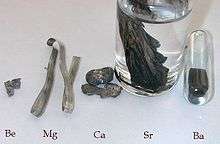
Beryllium occurs in the earth's crust at a concentration of two to six parts per million (ppm),[45] much of which is in soils, where it has a concentration of six ppm. Beryllium is one of the rarest elements in seawater, even rarer than elements such as scandium, with a concentration of 0.2 parts per trillion.[46][47] However, in freshwater, beryllium is somewhat more common, with a concentration of 0.1 parts per billion.[48]
Magnesium and calcium are very common in the earth's crust, being respectively the fifth- eighth-most-abundant elements. None of the alkaline earth metals are found in their elemental state. Common magnesium—containing minerals are carnallite, magnesite, and dolomite. Common calcium-containing minerals are chalk, limestone, gypsum, and anhydrite.[2]
Strontium is the fifteenth-most-abundant element in the Earth's crust. The principal minerals are celestite and strontianite.[49] Barium is slightly less common, much of it in the mineral barite.[50]
Radium, being a decay product of uranium, is found in all uranium-bearing ores.[51] Due to its relatively short half-life,[52] radium from the Earth's early history has decayed, and present-day samples have all come from the much slower decay of uranium.[51]
Production
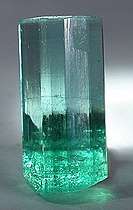
Most beryllium is extracted from beryllium hydroxide. One production method is sintering, done by mixing beryl, sodium fluorosilicate, and soda at high temperatures to form sodium fluoroberyllate, aluminium oxide, and silicon dioxide. A solution of sodium fluoroberyllate and sodium hydroxide in water is then used to form beryllium hydroxide by precipitation. Alternatively, in the melt method, powdered beryl is heated to high temperature, cooled with water, then heated again slightly in sulfuric acid, eventually yielding beryllium hydroxide. The beryllium hydroxide from either method then produces beryllium fluoride and beryllium chloride through a somewhat long process. Electrolysis or heating of these compounds can then produce beryllium.[7]
In general, strontium carbonate is extracted from the mineral celestite through two methods: by leaching the celestite with sodium carbonate, or in a more complicated way involving coal.[53]
To produce barium, barite is subjected to barium sulfide by carbothermic reduction. which is dissolved with other elements to form other compounds, such as barium nitrate. These in turn are thermally decompressed into barium oxide, which eventually yields pure barium after a reaction with aluminium.[50] The most important supplier of barium is China, which produces more than 50% of world supply.[54]
Applications
Beryllium is used mostly for military applications,[55] but there are other uses of beryllium, as well. In electronics, beryllium is used as a p-type dopant in some semiconductors,[56] and beryllium oxide is used as a high-strength electrical insulator and heat conductor.[57] Due to its light weight and other properties, beryllium is also used in mechanics when stiffness, light weight, and dimensional stability are required at wide temperature ranges.[58][59]
Magnesium has many uses. It offers advantages over other materials such as aluminium, although this usage has fallen out of favor due to magnesium's flammability.[60] Magnesium is also often alloyed with aluminium or zinc to form materials with more desirable properties than any pure metal.[61] Magnesium has many other uses in industrial applications, such as having a role in the production of iron and steel, and the production of titanium.[62]
Calcium also has many uses. One of its uses is as a reducing agent in the separation of other metals from ore, such as uranium. It is also used in the production of the alloys of many metals, such as aluminium and copper alloys, and is also used to deoxidize alloys as well. Calcium also has a role in the making of cheese, mortars, and cement.[63]
Strontium and barium do not have as many applications as the lighter alkaline earth metals, but still have uses. Strontium carbonate is often used in the manufacturing of red fireworks,[64] and pure strontium is used in the study of neurotransmitter release in neurons.[65][66] Radioactive strontium-90 finds some use in RTGs,[67][68] which utilize its decay heat. Barium has some use in vacuum tubes to remove gases,[50] and barium sulfate has many uses in the petroleum industry,[4] as well as other industries.[4][50][69]
Due to its radioactivity, radium no longer has many applications, but it used to have many. Radium used to be used often in luminous paints,[70] although this use was stopped after workers got sick.[71] As people used to think that radioactivity was a good thing, radium used to be added to drinking water, toothpaste, and many other products, although they are also not used anymore due to their health effects.[60] Radium is no longer even used for its radioactive properties, as there are more powerful and safer emitters than radium.[72][73]
Representative reactions of alkaline earth metals
Reaction with halogens
- Ca + Cl2 → CaCl2
Anhydrous calcium chloride is a hygroscopic substance that is used as a desiccant. Exposed to air, it will absorb water vapour from the air, forming a solution. This property is known as deliquescence.
Reaction with oxygen
- Ca + 1/2O2 → CaO
- Mg + 1/2O2 → MgO
Reaction with sulphur
- Ca + 1/8S8 → CaS
Reaction with carbon
With carbon, they form acetylides directly. Beryllium forms carbide.
- 2Be + C → Be2C
- CaO + 3C → CaC2 + CO (at 25000C in furnace)
- CaC2 + 2H2O → Ca(OH)2 + C2H2
- Mg2C3 + 4H2O → 2Mg(OH)2 + C3H4
Reaction with nitrogen
Only Be and Mg form nitrides directly.
- 3Be + N2 → Be3N2
- 3Mg + N2 → Mg3N2
Reaction with hydrogen
Alkaline earth metals react with hydrogen to generate saline hydride that are unstable in water.
- Ca + H2 → CaH2
Reaction with water
Ca, Sr and Ba readily react with water to form hydroxide and hydrogen gas. Be and Mg are passivated by an impervious layer of oxide. However, amalgamated magnesium will react with water vapour.
- Mg + H2O → MgO + H2
Reaction with acidic oxides
Alkaline earth metals reduce the nonmetal from its oxide.
- 2Mg + SiO2 → 2MgO + Si
- 2Mg + CO2 → 2MgO + C (in solid carbon dioxide)
Reaction with acids
- Mg + 2HCl → MgCl2 + H2
- Be + 2HCl → BeCl2 + H2
Reaction with bases
Be exhibits amphoteric properties. It dissolves in concentrated sodium hydroxide.
- Be + NaOH + 2H2O → Na[Be(OH)3] + H2
Reaction with alkyl halides
Magnesium reacts with alkyl halides via an insertion reaction to generate Grignard reagents.
- RX + Mg → RMgX (in anhydrous ether)
Identification of alkaline earth cations
The flame test
The table below[74] presents the colours observed when the flame of a Bunsen burner is exposed to salts of alkaline earth metals. Be and Mg do not impart colour to the flame due to their small size.[75]
| Metal | Colour |
|---|---|
| Ca | Brick-red |
| Sr | Crimson red |
| Ba | Green/Yellow |
| Ra | Carmine red |
In solution
Mg2+
Disodium phosphate is a very selective reagent for magnesium ions and, in the presence of ammonium salts and ammonia, forms a white precipitate of ammonium magnesium phosphate.
- Mg2+ + NH3 + Na2HPO4 → (NH4)MgPO4 + 2Na+
Ca2+
Ca2+ forms a white precipitate with ammonium oxalate. Calcium oxalate is insoluble in water, but is soluble in mineral acids.
- Ca2+ + (COO)2(NH4)2 → (COO)2Ca + NH4+
Sr2+
Strontium ions precipitate with soluble sulphate salts.
- Sr2+ + Na2SO4 → SrSO4 + 2Na+
All ions of alkaline earth metals form white precipitate with ammonium carbonate in the presence of ammonium chloride and ammonia.
Compounds of alkaline earth metals
Oxides
The alkaline earth metal oxides are formed from the thermal decomposition of the corresponding carbonates.
- CaCO3 → CaO + CO2 (at approx. 9000C)
In laboratory, they are obtained from hydroxides:
- Mg(OH)2 → MgO + H2O
or nitrates:
- Ca(NO3)2 → CaO + 2NO2 + 1/2O2
The oxides exhibit basic character: they turn phenolphthalein red and litmus, blue. They react with water to form hydroxides in an exothermic reaction.
- CaO + H2O → Ca(OH)2 + Q
Calcium oxide reacts with carbon to form acetylide.
- CaO + 3C → CaC2 + CO (at 25000)
- CaC2 + N2 → CaCN2 + C
- CaCN2 + H2SO4 → CaSO4 + H2N—CN
- H2N—CN + H2O → (H2N)CO (urea)
- CaCN2 + 2H2O → CaCO3 + NH3
Hydroxides
They are generated from the corresponding oxides on reaction with water. They exhibit basic character: they turn phenolphthalein pink and litmus, blue. Beryllium hydroxide is an exception as it exhibits amphoteric character.
- Be(OH)2 + 2HCl → BeCl2 + H2O
- Be(OH)2 + NaOH → Na[Be(OH)3]
Salts
Ca and Mg are found in nature in many compounds such as dolomite, aragonite, magnesite (carbonate rocks). Calcium and magnesium ions are found in hard water. Hard water represents a multifold issue. It is of great interest to remove these ions, thus softening the water. This procedure can be done using reagents such as calcium hydroxide, sodium carbonate or sodium phosphate. A more common method is to use ion-exchange aluminosilicates or ion-exchange resins that trap Ca2+ and Mg2+ and liberate Na+ instead:
- Na2O·Al2O3·6SiO2 + Ca2+ → CaO·Al2O3·6SiO2 + 2Na+
Biological role and precautions
Magnesium and calcium are ubiquitous and essential to all known living organisms. They are involved in more than one role, with, for example, magnesium or calcium ion pumps playing a role in some cellular processes, magnesium functioning as the active center in some enzymes, and calcium salts taking a structural role, most notably in bones.
Strontium plays an important role in marine aquatic life, especially hard corals, which use strontium to build their exoskeletons. It and barium have some uses in medicine, for example "barium meals" in radiographic imaging, whilst strontium compounds are employed in some toothpastes. Excessive amounts of strontium-90 are toxic due to its radioactivity and strontium-90 mimics calcium and then can kill.
Beryllium and radium, however, are toxic. Beryllium's low aqueous solubility means it is rarely available to biological systems; it has no known role in living organisms and, when encountered by them, is usually highly toxic.[7] Radium has a low availability and is highly radioactive, making it toxic to life.
Extensions
The next alkaline earth metal after radium is thought to be element 120, although this may not be true due to relativistic effects.[76] The synthesis of element 120 was first attempted in March 2007, when a team at the Flerov Laboratory of Nuclear Reactions in Dubna bombarded plutonium-244 with iron-58 ions; however, no atoms were produced, leading to a limit of 400 fb for the cross-section at the energy studied.[77] In April 2007, a team at the GSI attempted to create element 120 by bombarding uranium-238 with nickel-64, although no atoms were detected, leading to a limit of 1.6 pb for the reaction. Synthesis was again attempted at higher sensitivities, although no atoms were detected. Other reactions have been tried, although all have been met with failure.[78]
The chemistry of element 120 is predicted to be closer to that of calcium or strontium[79] instead of barium or radium. This is unusual as periodic trends would predict element 120 to be more reactive than barium and radium. This lowered reactivity is due to the expected energies of element 120's valence electrons, increasing element 120's ionization energy and decreasing the metallic and ionic radii.[79]
The next alkaline earth metal after element 120 has not been definitely predicted. Although a simple extrapolation using the Aufbau principle would suggest that element 170 is a congener of 120, relativistic effects may render such an extrapolation invalid. The next element with properties similar to the alkaline earth metals has been predicted to be element 166, though due to overlapping orbitals and lower energy gap below the 9s subshell, element 166 may instead be placed in group 12, below copernicium.[80][81]
Notes
- Noble gas notation is used for conciseness; the nearest noble gas that precedes the element in question is written first, and then the electron configuration is continued from that point forward.
- Energies are given in −kJ/mol, solubilities in mol/L; HE means "hydration energy".
- The number given in parentheses refers to the measurement uncertainty. This uncertainty applies to the least significant figure(s) of the number prior to the parenthesized value (i.e., counting from rightmost digit to left). For instance, 1.00794(7) stands for 1.00794±0.00007, whereas 1.00794(72) stands for 1.00794±0.00072.[15]
- The element does not have any stable nuclides, and a value in brackets indicates the mass number of the longest-lived isotope of the element.[16][17]
- The color of the flame test of pure radium has never been observed; the crimson-red color is an extrapolation from the flame test color of its compounds.[20]
References
- International Union of Pure and Applied Chemistry (2005). Nomenclature of Inorganic Chemistry (IUPAC Recommendations 2005). Cambridge (UK): RSC–IUPAC. ISBN 0-85404-438-8. pp. 51. Electronic version..
- Royal Society of Chemistry. "Visual Elements: Group 2–The Alkaline Earth Metals". Visual Elements. Royal Society of Chemistry. Archived from the original on 5 October 2011. Retrieved 13 January 2012.
- "Periodic Table: Atomic Properties of the Elements" (PDF). nist.gov. National Institute of Standards and Technology. September 2010. Archived (PDF) from the original on 2012-08-09. Retrieved 17 February 2012.
- Lide, D. R., ed. (2003). CRC Handbook of Chemistry and Physics (84th ed.). Boca Raton, FL: CRC Press.
- Greenwood, Norman N.; Earnshaw, Alan (1997). Chemistry of the Elements (2nd ed.). Butterworth-Heinemann. ISBN 978-0-08-037941-8.
- "Abundance in Earth's Crust". WebElements.com. Archived from the original on 9 March 2007. Retrieved 14 April 2007.
- Jakubke, Hans-Dieter; Jeschkeit, Hans, eds. (1994). Concise Encyclopedia Chemistry. trans. rev. Eagleson, Mary. Berlin: Walter de Gruyter.
- Bell, N. A. (1972). "Beryllium halide and pseudohalides". In Emeléus, Harry Julius; Sharpe, A. G. (eds.). Advances in inorganic chemistry and radiochemistry, Volume 14. New York: Academic Press. pp. 256–277. ISBN 978-0-12-023614-5.
- Walsh, Kenneth A. (2009-08-01). Beryllium chemistry and processing. ASM International. pp. 99–102, 118–119. ISBN 978-0-87170-721-5.
- Hertz, Raymond K. (1987). "General analytical chemistry of beryllium". In Coyle, Francis T. (ed.). Chemical analysis of metals: a symposium. ASTM. pp. 74–75. ISBN 978-0-8031-0942-1.
- Wiberg, Wiberg & Holleman 2001, pp. XXXVI–XXXVII.
- Wiberg, Wiberg & Holleman 2001, p. XXXVI.
- Lide 2004, p. 12-23.
- Wiberg, Wiberg & Holleman 2001, p. 1073.
- "Standard Uncertainty and Relative Standard Uncertainty". CODATA reference. National Institute of Standards and Technology. Archived from the original on 16 October 2011. Retrieved 26 September 2011.
- Wieser, Michael E.; Berglund, Michael (2009). "Atomic weights of the elements 2007 (IUPAC Technical Report)" (PDF). Pure Appl. Chem. IUPAC. 81 (11): 2131–2156. doi:10.1351/PAC-REP-09-08-03. Archived (PDF) from the original on 2 November 2012. Retrieved 7 February 2012.
- Wieser, Michael E.; Coplen, Tyler B. (2011). "Atomic weights of the elements 2009 (IUPAC Technical Report)" (PDF). Pure Appl. Chem. IUPAC. 83 (2): 359–396. doi:10.1351/PAC-REP-10-09-14. Archived (PDF) from the original on 11 February 2012. Retrieved 11 February 2012.
- Slater, J. C. (1964). "Atomic Radii in Crystals". Journal of Chemical Physics. 41 (10): 3199–3205. Bibcode:1964JChPh..41.3199S. doi:10.1063/1.1725697.
- Jensen, William B. (2003). "The Place of Zinc, Cadmium, and Mercury in the Periodic Table" (PDF). Journal of Chemical Education. American Chemical Society. 80 (8): 952–961. Bibcode:2003JChEd..80..952J. doi:10.1021/ed080p952. Archived from the original (PDF) on 2010-06-11. Retrieved 2012-05-06.
- Kirby, H. W; Salutsky, Murrell L (1964). The Radiochemistry of Radium. National Academies Press.
- Audi, Georges; Bersillon, Olivier; Blachot, Jean; Wapstra, Aaldert Hendrik (2003), "The NUBASE evaluation of nuclear and decay properties", Nuclear Physics A, 729: 3–128, Bibcode:2003NuPhA.729....3A, doi:10.1016/j.nuclphysa.2003.11.001
- Richard B. Firestone (15 March 2010). "Isotopes of Calcium (Z=20)". Lawrence Berkeley National Laboratory. Archived from the original on 6 May 2012. Retrieved 12 June 2012.
- Richard B. Firestone (15 March 2010). "Isotopes of Barium (Z=56)". Lawrence Berkeley National Laboratory. Archived from the original on 6 May 2012. Retrieved 12 June 2012.
- Robert E. Krebs (2006). The history and use of our earth's chemical elements: a reference guide. Greenwood Publishing Group. pp. 65–81. ISBN 0-313-33438-2.
- Miller, M. Michael. "Commodity report:Lime" (PDF). United States Geological Survey. Archived (PDF) from the original on 2011-11-12. Retrieved 2012-03-06.
- Weeks 1968, p. 535.
- Weeks, Mary Elvira (1932). "The discovery of the elements. X. The alkaline earth metals and magnesium and cadmium". Journal of Chemical Education. 9 (6): 1046. Bibcode:1932JChEd...9.1046W. doi:10.1021/ed009p1046.
- Weeks, Mary Elvira (1932). "The discovery of the elements. XII. Other elements isolated with the aid of potassium and sodium: Beryllium, boron, silicon, and aluminum". Journal of Chemical Education. 9 (8): 1386. Bibcode:1932JChEd...9.1386W. doi:10.1021/ed009p1386.
- Weeks, Mary Elvira (1933). "The discovery of the elements. XIX. The radioactive elements". Journal of Chemical Education. 10 (2): 79. Bibcode:1933JChEd..10...79W. doi:10.1021/ed010p79.
- Weeks 1968, p. 537.
- Vauquelin, Louis-Nicolas (1798). "De l'Aiguemarine, ou Béril; et découverie d'une terre nouvelle dans cette pierre". Annales de Chimie (26): 155–169. Archived from the original on 2016-04-27.
- Wöhler, Friedrich (1828). "Ueber das Beryllium und Yttrium". Annalen der Physik. 89 (8): 577–582. Bibcode:1828AnP....89..577W. doi:10.1002/andp.18280890805.
- Bussy, Antoine (1828). "D'une travail qu'il a entrepris sur le glucinium". Journal de Chimie Medicale (4): 456–457. Archived from the original on 2016-05-22.
- Weeks 1968, p. 539.
- Davy, H. (1808). "Electro-chemical researches on the decomposition of the earths; with observations on the metals obtained from the alkaline earths, and on the amalgam procured from ammonia". Philosophical Transactions of the Royal Society of London. 98: 333–370. Bibcode:1808RSPT...98..333D. doi:10.1098/rstl.1808.0023. JSTOR 107302. Archived from the original on 2015-09-30.
- Williams, Richard (2004). Lime Kilns and Lime Burning. p. 4. ISBN 978-0-7478-0596-0.
- Oates, J. A. H (2008-07-01). Lime and Limestone: Chemistry and Technology, Production and Uses. ISBN 978-3-527-61201-7.
- Davy H (1808). "Electro-chemical researches on the decomposition of the earths; with observations on the metals obtained from the alkaline earths, and on the amalgam procured from ammonia". Philosophical Transactions of the Royal Society of London. 98: 333–370. Bibcode:1808RSPT...98..333D. doi:10.1098/rstl.1808.0023. Archived from the original on 2015-09-30.
- Murray, T. (1993). "Elemementary Scots: The Discovery of Strontium". Scottish Medical Journal. 38 (6): 188–189. doi:10.1177/003693309303800611. PMID 8146640.
- Davy, Humphry (1808). researches on the decomposition of the earths; with observations on the metals obtained from the alkaline earths, and on the amalgam procured from ammonia. 98. Philosophical Transactions of the Royal Society of London. pp. 333–370. Archived from the original on 2015-09-30.
- "Masthead". Annalen der Chemie und Pharmacie. 93 (3): fmi. 1855. doi:10.1002/jlac.18550930301.
- Wagner, Rud.; Neubauer, C.; Deville, H. Sainte-Claire; Sorel; Wagenmann, L.; Techniker; Girard, Aimé (1856). "Notizen". Journal für Praktische Chemie. 67: 490–508. doi:10.1002/prac.18560670194.
- Curie, Pierre; Curie, Marie; Bémont, Gustave (1898). "Sur une nouvelle substance fortement radio-active, contenue dans la pechblende (On a new, strongly radioactive substance contained in pitchblende)". Comptes Rendus. 127: 1215–1217. Archived from the original on 2009-08-06. Retrieved 2009-08-01.
- "radium". Online Etymology Dictionary. Archived from the original on 13 January 2012. Retrieved 20 August 2011.
- Merck contributors (2006). O'Neil, Marydale J.; Heckelman, Patricia E.; Roman, Cherie B. (eds.). The Merck Index: An Encyclopedia of Chemicals, Drugs, and Biologicals (14th ed.). Whitehouse Station, NJ, USA: Merck Research Laboratories, Merck & Co., Inc. ISBN 0-911910-00-X.
- Emsley, John (2001). Nature's Building Blocks: An A–Z Guide to the Elements. Oxford, England, UK: Oxford University Press. ISBN 0-19-850340-7.
- "Abundance in oceans". Mark Winter, The University of Sheffield and WebElements Ltd, UK. WebElements. Archived from the original on 5 August 2011. Retrieved 6 August 2011.
- "Abundance in stream water". Mark Winter, The University of Sheffield and WebElements Ltd, UK. WebElements. Archived from the original on 4 August 2011. Retrieved 6 August 2011.
- Ober, Joyce A. "Mineral Commodity Summaries 2010: Strontium" (PDF). United States Geological Survey. Archived (PDF) from the original on 2010-07-16. Retrieved 2010-05-14.
- Kresse, Robert; Baudis, Ulrich; Jäger, Paul; Riechers, H. Hermann; Wagner, Heinz; Winkler, Jocher; Wolf, Hans Uwe (2007). "Barium and Barium Compounds". In Ullman, Franz (ed.). Ullmann's Encyclopedia of Industrial Chemistry. Wiley-VCH. doi:10.1002/14356007.a03_325.pub2. ISBN 978-3527306732.
- "Radium" Archived 2012-11-15 at the Wayback Machine, Los Alamos National Laboratory. Retrieved on 2009-08-05.
- Malley, Marjorie C (2011-08-25). Radioactivity. pp. 115–. ISBN 978-0-19-983178-4. Archived from the original on 2015-09-05.
- Kemal, Mevlüt; Arslan, V; Akar, A; Canbazoglu, M (1996). Production of SrCO, by black ash process: Determination of reductive roasting parameters. p. 401. ISBN 9789054108290. Archived from the original on 2016-04-27.
- Miller, M. M. "Barite" (PDF). USGS.gov. Archived (PDF) from the original on 2012-07-07.
- Petzow, G. N.; Aldinger, F.; Jönsson, S.; Welge, P.; Van Kampen, V.; Mensing, T.; Brüning, T. (2005). "Beryllium and Beryllium Compounds". Ullmann's Encyclopedia of Industrial Chemistry. doi:10.1002/14356007.a04_011.pub2. ISBN 3527306730.
- Diehl, Roland (2000). High-power diode lasers. Springer. p. 104. ISBN 3-540-66693-1.
- "Purdue engineers create safer, more efficient nuclear fuel, model its performance". Purdue University. 27 September 2005. Archived from the original on 27 May 2012. Retrieved 18 September 2008.
- Davis, Joseph R. (1998). "Beryllium". Metals handbook. ASM International. pp. 690–691. ISBN 978-0-87170-654-6.
- Schwartz, Mel M. (2002). Encyclopedia of materials, parts, and finishes. CRC Press. p. 62. ISBN 1-56676-661-3.
- Gray, Theodore (2009). The Elements: A Visual Exploration of Every Known Atom in the Universe. New York: Black Dog & Leventhal Publishers. ISBN 978-1-57912-814-2.
- Baker, Hugh D. R.; Avedesian, Michael (1999). Magnesium and magnesium alloys. Materials Park, OH: Materials Information Society. p. 4. ISBN 0-87170-657-1.
- Amundsen, K.; Aune, T. K.; Bakke, P.; Eklund, H. R.; Haagensen, J. Ö.; Nicolas, C.; Rosenkilde, C.; Van Den Bremt, S.; Wallevik, O. (2003). "Magnesium". Ullmann's Encyclopedia of Industrial Chemistry. doi:10.1002/14356007.a15_559. ISBN 3527306730.
- Lide, D. R., ed. (2005). CRC Handbook of Chemistry and Physics (86th ed.). Boca Raton (FL): CRC Press. ISBN 0-8493-0486-5.
- Moreno, Teresa; Querol, Xavier; Alastuey, Andrés; Cruz Minguillón, Mari; Pey, Jorge; Rodriguez, Sergio; Vicente Miró, José; Felis, Carles; Gibbons, Wes (2007). "Recreational atmospheric pollution episodes: Inhalable metalliferous particles from firework displays" (PDF). Atmospheric Environment. 41 (5): 913. Bibcode:2007AtmEn..41..913M. doi:10.1016/j.atmosenv.2006.09.019. hdl:10261/185836.
- Miledi, R. (1966). "Strontium as a Substitute for Calcium in the Process of Transmitter Release at the Neuromuscular Junction". Nature. 212 (5067): 1233–4. Bibcode:1966Natur.212.1233M. doi:10.1038/2121233a0. PMID 21090447.
- Hagler D.J., Jr; Goda Y. (2001). "Properties of synchronous and asynchronous release during pulse train depression in cultured hippocampal neurons". J. Neurophysiol. 85 (6): 2324–34. doi:10.1152/jn.2001.85.6.2324. PMID 11387379.
- Standring, WJF; Selnæs, ØG; Sneve, M; Finne, IE; Hosseini, A; Amundsen, I; Strand, P (2005), Assessment of environmental, health and safety consequences of decommissioning radioisotope thermal generators (RTGs) in Northwest Russia (PDF), Østerås: Norwegian Radiation Protection Authority
- "Power Sources for Remote Arctic Applications" (PDF). Washington, DC: U.S. Congress, Office of Technology Assessment. June 1994. OTA-BP-ETI-129.
- Jones, Chris J.; Thornback, John (2007). Medicinal applications of coordination chemistry. Royal Society of Chemistry. p. 102. ISBN 978-0-85404-596-9.
- Terrill Jr, JG; Ingraham Sc, 2nd; Moeller, DW (1954). "Radium in the healing arts and in industry: Radiation exposure in the United States". Public Health Reports. 69 (3): 255–62. doi:10.2307/4588736. JSTOR 4588736. PMC 2024184. PMID 13134440.
- "Mass Media & Environmental Conflict – Radium Girls". Archived from the original on 2009-07-21. Retrieved 2009-08-01.
- Committee On Radiation Source Use And Replacement, National Research Council (U.S.); Nuclear And Radiation Studies Board, National Research Council (U.S.) (January 2008). Radiation source use and replacement: Abbreviated version. p. 24. ISBN 978-0-309-11014-3. Archived from the original on 2015-09-05.
- Bentel, Gunilla Carleson (1996). Radiation therapy planning. p. 8. ISBN 978-0-07-005115-7. Archived from the original on 2015-09-05.
- http://www.docbrown.info/page13/ChemicalTests/ChemicalTestsc.htm
- https://www.askiitians.com/forums/Physical-Chemistry/beryllium-and-magnesium-do-not-give-colour-to-flam_83845.htm
- Gäggeler, Heinz W. (5–7 November 2007). "Gas Phase Chemistry of Superheavy Elements" (PDF). Lecture Course Texas A&M. Archived from the original (PDF) on 20 February 2012. Retrieved 26 February 2012.
- Oganessian, Yu. Ts.; Utyonkov, V.; Lobanov, Yu.; Abdullin, F.; Polyakov, A.; Sagaidak, R.; Shirokovsky, I.; Tsyganov, Yu.; Voinov, A. (2009). "Attempt to produce element 120 in the 244Pu+58Fe reaction". Phys. Rev. C. 79 (2): 024603. Bibcode:2009PhRvC..79b4603O. doi:10.1103/PhysRevC.79.024603.
- http://fias.uni-frankfurt.de/kollo/Duellmann_FIAS-Kolloquium.pdf%5B%5D
- Seaborg, G. T. (c. 2006). "transuranium element (chemical element)". Encyclopædia Britannica. Archived from the original on 30 November 2010. Retrieved 16 March 2010.
- Fricke, B.; Greiner, W.; Waber, J. T. (1971). "The continuation of the periodic table up to Z = 172. The chemistry of superheavy elements". Theoretica Chimica Acta. 21 (3): 235–260. doi:10.1007/BF01172015.
- Hoffman, Darleane C.; Lee, Diana M.; Pershina, Valeria (2006). "Transactinides and the future elements". In Morss; Edelstein, Norman M.; Fuger, Jean (eds.). The Chemistry of the Actinide and Transactinide Elements (3rd ed.). Dordrecht, The Netherlands: Springer Science+Business Media. ISBN 978-1-4020-3555-5.
Bibliography
- Weeks, Mary Elvira; Leichester, Henry M. (1968). Discovery of the Elements. Easton, PA: Journal of Chemical Education. LCCCN 68-15217.
Further reading
- Group 2 – Alkaline Earth Metals, Royal Chemistry Society.
- Hogan, C.Michael. 2010. Calcium. eds. A.Jorgensen, C. Cleveland. Encyclopedia of Earth. National Council for Science and the Environment.
- Maguire, Michael E. "Alkaline Earth Metals." Chemistry: Foundations and Applications. Ed. J. J. Lagowski. Vol. 1. New York: Macmillan Reference USA, 2004. 33–34. 4 vols. Gale Virtual Reference Library. Thomson Gale.
- Silberberg, M.S., Chemistry: The molecular nature of Matter and Change (3e édition, McGraw-Hill 2009)
- Petrucci R.H., Harwood W.S. et Herring F.G., General Chemistry (8e édition, Prentice-Hall 2002)